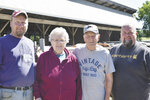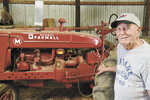

AVON, Minn. — When asked what his favorite chore has been throughout 91 years of living on his family’s dairy farm near Avon, Alfred Ritter chose an unlikely one.
“My favorite chore was picking rocks because then I could be all alone and nobody would bother me,” Alfred said. “I always think (picking rocks) can keep you in shape with the bending down and picking up.”
Alfred picked rocks until he was 85 years old.
“I think if somebody else drove the tractor, and I would be out in the field, I could still pick,” he said.
However, Alfred no longer needs to pick rocks to stay fit. His passion for walking takes care of that. The shortest walk he takes each day is half a mile, from the house he shares with his wife, Adeline, to the tiestall barn on the farm. There he helps his sons, Glen and Mike, who operate the 385-acre farm as the fourth generation. They milk a herd of 80 cows and grow corn, soybeans and alfalfa. Alfred helps his sons every morning.
“I scrape the aisles, help straw the calf pens and all kinds of stuff,” Alfred said.
For most 91-year-olds, such work each day would be a feat unto itself, but for nearly 20 years, Alfred has participated in several 5K races each year, choosing to walk instead of run. Most of those races have taken place during festivals in area towns, but Alfred has completed seven 5K races at Grandma’s Marathon in Duluth.
“I already signed up for this year,” Alfred said.
When he was 85, Alfred completed all 13 miles of Grandma’s half marathon. Alfred keeps in shape for races by going on long walks every day.
“I walked this morning already,” Alfred said. “I walked three miles.”
Three miles is a short walk for Alfred. He often walks for several hours such as during excursions on foot from his farm to the towns of St. Anna,13 miles away, St. Martin, 16 miles, and Cold Spring, 18 miles. Often, his daughter accompanies him on longer walks and 5K races.
Adeline, his wife of 67 years, said Alfred began taking long walks when his sons took over the farm.
“When he quit milking at 65, he started walking around the fields,” Adeline said. “He didn’t walk on the roads then.”
Alfred agreed.
“I got rid of the (farming) troubles,” he said. “I think that’s why I went walking. I was so glad everything was over — and walking was fun.”
The 5K races came a few years later.
“It took quite a while before I had the courage to go,” Alfred said.
When the Ritters handed over the reins of the farm to their sons Glen and Mike, after having farming together from the time they married in 1957 and also raising seven children, Alfred and Adeline found themselves with more time for other things . Besides Alfred’s walking, the couple finally took their first vacations, one to Alaska to visit a daughter and the other to California to visit Alfred’s brother.
Alfred and Adeline have also found more time to reminisce about their farm — homesteaded by Alfred’s grandfather in 1879 —and how much farming has changed over the years. Alfred’s family was using horses to farm when he was first old enough to help, and prices for farms and equipment were significantly lower.
“My brother-in-law bought a farm near Avon, and it was $8,000 for the cattle and everything,” Alfred said. “My brother’s farm was also $8,000. A bigger farm around there went for $14,000, and my other brother’s farm was $16,000. I spent more to build my barn than it cost for all those farms together.”
The barn he built in 1978 cost about $100,000.
Adeline remembered a time when the old barn they once had needed a new roof and was temporarily covered in plastic.
“It rained hard and leaked through and filled the gutters, so we had to take 5-gallon pails, bail out the gutters and dump it out of the east windows,” Adeline said. “I remember a salesman came by and said, ‘If I had to bail in there, those cows would be in St. Paul (at the stockyard).’ I said, ‘We just got them paid for, so they are going to stay here.’”
It was a time when farmers did not make upgrades or purchases unless they had most, if not all, of the cash in hand.
“We had the old (International Harvesters and Massey Fergusons), not the big tractors we have now,” Adeline said. “Years ago, it was different with buying stuff because there wasn’t the credit they have out there now. We never really bought anything until we knew we could pay for it.”
The first big tractor Alfred and Adeline bought cost $39,000 in the late 1980s. Glen said they still use it on the farm.
“It now has 17,000 hours on it, but it is in good shape,” Glen said.
The Ritters said they appreciate keeping the old tractors running and in the family.
“We still have the old Farmall that my father bought,” Alfred said. “I think that was $1,200.”
The tractor, an International Harvester Farmall M, was purchased brand new by Alfred’s father in 1951 and was restored by Glen’s son, Cole, around five years ago. Today, it is mostly used to run the feed grinder.
“We didn’t have everything that they have nowadays, but we had enough,” Alfred said. “We never worried about money. We’ve had a good life.”
Like the old tractors on his family’s farm, Alfred keeps on going. He said he does not see his walking exploits or helping on the farm at his advanced age as being anything remarkable.
“What else am I going to do?” he said. “It’s something to do. It gets me off the couch and gets me to work.”
Plus, physical activity fits into his dad’s motto for living, Glen said.
“(Dad) would always say, ‘As long as you can work and eat, you’ll be good,’” he said.
Alfred also credited his mother for giving him that philosophy.
“My mother always said, ‘Hard work would never kill you,’” Alfred said. “’It’s that other stuff that will get you.’”
Tiffany Klaphake contributed to this article.
Comments
No comments on this item Please log in to comment by clicking here